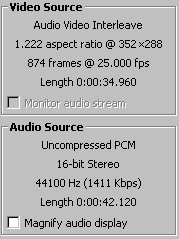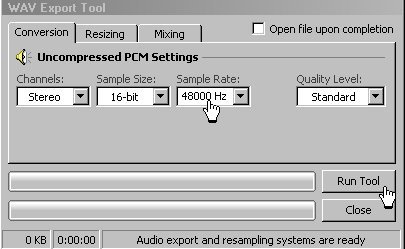BJS Guide : Syncview - How simple is this .
This guide will show you how to realign a wav , and convert it , suitable for dvd output .
Launch syncview .
Load the avi (video only , no audio) , you wish to resync with audio , and wait
Load wav associated with avi , and wait
Now we see the time length difference's to the right .
Go to Tool's , Export audio to wav file .
Resizing tab , select "match video length" , and "by compressing encoding rate to ?????mhz" .
Hit "run tool" .
You will be asked for name and place for it to go ... call it adjust.wav , and let it perform it's function .
Close that window when it's done the job .
Under audio , you now double click it , and select the new audio file that was just written out .
Go back to Tool's , Export audio to wav file ... as adjust2.wav
Now go to "conversion" tab , and set to 44.1khz , and repeat processing step .
Here I have chosen 48khz , as the audio is being used for a dvd project .
Close syncview when the re-conversion is completed .
This is the "CORRECT" method for using syncview to correct audio lenght's for clip's , and frequency conversion's for mpeg's , dvd .
You can of course avoid the final process of frequency change , which will be fine for pc play back .
===================
Of course , this is for very good where the audio is not out by too much , and just need's simple realignment with it's video ... ie ... for whatever reason the audio came out a few second's short in actual length than the video , and need's to be slightly stretched / shrunk , to match the video length ... as experienced with pal to nstc or nstc to pal conversion's where the audio wasn't done properly
Closed Thread
Results 1 to 8 of 8
-
-
Cause it dont work this way ... check out fmod and you'll see what it dose behind the scene .
The first part is to match the video's length , which any tool can do simply by changing the frequency so the audio match's the video's length .
What fmod dose , is keep it bit for bit during the reprocessing to the new frequency without affecting the new length ... it's acurate .
You must use resize tab first ... check what it say's the frequency will be changed too , and note the fact you cannot set the frequency under the conversion tab till after the first process has been performed .
By simply changing the frequency under the "conversion" tab , all your doing is affecting the length of the file and introducing distortion ... and the new file will not match the time length of the video it is being resynced too ... and thus , your forced to do it the correct way as explained in this guide .
I should have noted that this method should only be done if the audio is out by a small amount ... and brilliant for those who screwed up a pal to nstc or nstc to pal conversion process .
Some , if not most programs , when converting from one frequency to another change the length of the stream which is not what user's want ... fmod correct's this ... yet at around $6000 for a license , it's within my price tag , but just too steep to justify the purchase what with vista and 64bit around the corner .
If I am going to waste $6000 , I'll wait till 64bit tool's are a little more advanced .
-
I think you're confused.
You describe a two-step process, but you can do BOTH parts (resizing and re-sampling) in one step.
What you are doing is resampling @ 44.1 (to resize), and then resampling again @ 48 (to reformat).
Running both steps in separate operations is a waste of time. It's got to be taking you at least 60% longer. Just set the NEW target sampling rate from the start, continue with the rest of your steps, but ignore the last part.
FYI
"...and note the fact you cannot set the frequency under the conversion tab till after the first process has been performed"
Not true; I do it all the time. This might be related to why you are doing it the LONG way.
-
No you can not ... it will not be in sync ... and I have just repeated the process again .
You cannot set the conversion rate to be used under conversion tab , if engaging the resizing tab features where audio is set to "by expanding the encoding rate too ???" in order to match the video's length .
If you try it any other way , you dont end up with 44.1khz or 48khz audio stream that match's the video's length , as this would return the audio to any other khz rate , which is not suitable for mpeg1 or mpeg if dealing with an end result as for dvd .
Your doing it incorrectly .
Where the blazes are you getting this part from :
"What you are doing is resampling @ 44.1 (to resize), and then resampling again @ 48 (to reformat). "
Take no notice of what is being reported in the pciture as to the original audio's bitrate ... pay more attention to the difference in the length between the two stream's , being the video , and this audio file , and then you'll see why it has to be done this way .
Take another look at the "resizing part" and what it reports the new frequency will be in order to make the audio the full length of the video clip and you will see why there is a need to do a 2 step process in the first place .
-
First of all, SyncView does not use fmod for re-sampling.
Second, before running any resizing operation, unload the video source because there is a bug that can throw off the length values. [This bug might be confusing you, too.]
Third, when you use re-sampling to resize, the new audio is NEVER really 44.1 or 48 anymore. The original audio data is re-encoded to xx.x Hz, but the WAV file header is exactly 44.1 or 48. That is how the stretching/shrinking is accomplished.
SyncView uses the desired "playback" frequency (Conversion tab) when it calculates the amount of compression/expansion needed to produce a wave file of length L. Set the sampling rate to 44.1 and you will see that SyncView uses a certain adustment. Now set the sampling rate to 48 and you will see that SyncView uses a different adjustment.
It doesn't matter what your target playback frequency is. SyncView will always stretch or shrink the new audio to the length that you want. If the length is correct but the audio is still not aligned, it means you are using the wrong technique to resize.
It is possible to get good results accidentally. It will depend on how much time difference there is and whether the original sync error is caused by a shift problem, rate problem, or both.
Again, there is no need to re-sample at x.xx Hz to resize and then later re-sample at x.xx Hz to reformat. You can do both in one operation.
-
Loading ... direct show ... fmod ...
It's there all right , and I dont have fmod installed ... it can only be one of two known .
"Second, before running any resizing operation, unload the video source because there is a bug that can throw off the length values. [This bug might be confusing you, too."
I have never had any issue with this program requiring the video to be unloaded at any stage what so ever .
I have confirmed the data in vdub , media info , gspot , and several other tool's , and the process is correct on all four system's here ... the audio is perfectly matched .
I have also confirmed that fmod dose not exist on any system ... so how is it being called via direct show ...
Hello ... whats this hiding in the syncview folder then ... fmodex.dll ... bingo ... I know what it is ... I hate upx compression .
End of discussion I think .
-
Look, stop arguing with me on technical points. I am the developer of the software and I know a LOT more about SyncView than you do.
SyncView does not use fmod for resampling. It uses another library, which you conveniently ignore. If I say there is a known bug, then there is a bug. I didn't say that the bug is necessarily affecting your sync projects. Rather, I told you how to avoid the bug--to be 100% certain.
I also advised you many weeks ago to check with me before posting your guide, so that I could confirm the information. [Review your threads.] You ignored that, too; and now I am correcting you.
Hence, this thread.
It's great that you prepared a helpful guide for users. It's not so great to be careless and presumptuous in your details. And perhaps you need to tone down the attitude a bit.
Similar Threads
-
Is there a better method?
By quxote in forum Authoring (DVD)Replies: 4Last Post: 24th Nov 2009, 16:32 -
What Is The Good/Correct Method to convert from 25fps into 29.97fps..
By hypershade in forum Newbie / General discussionsReplies: 1Last Post: 21st Mar 2009, 08:49 -
Correct pulldown or not
By carlmart in forum Video ConversionReplies: 2Last Post: 1st Feb 2009, 20:25 -
Got a DVD plays correct, copies correct but refuses to write on a blank DVD
By cemman in forum Authoring (DVD)Replies: 16Last Post: 21st Jul 2007, 16:09 -
SyncView and Audio Alignment: Unlocking the Power of the WAV Export Tool
By SDeC in forum User guidesReplies: 3Last Post: 21st May 2007, 12:00









